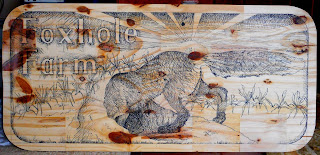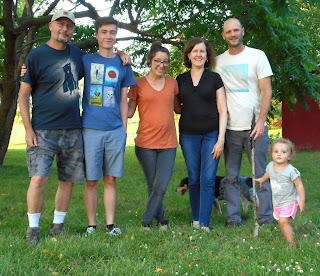My youngest son and I
recently returned from a trip to Ohio
 |
| Sam |
While there I talked a lot
with Rich and Sam about their farming methods which are far from
mainstream. They grow a large variety of
vegetables and fruits in two not extremely large fields which they maintain
mostly by hand. They don’t use
pesticides or weed killers. I used to
refer to their approach as “organic” until Rich explained to me that the
regulations that determine if produce can be certified as organic have been so
watered down as to make the designation practically meaningless. Their goal is to produce food that is safe to
eat while preserving the environment for our and future generations – an
admirable objective which necessarily results from a firm personal commitment,
for farming this way is time consuming and labor intensive.
 |
| Rich |
Unfortunately, the week we
spent at the farm will most likely end up being the hottest and most humid of
this summer. So when we were out in the
fields the sun was bearing down on us without mercy. I must admit that lollygagging and
socializing meant that we usually missed the prime early morning hours when the
sun was low and temps reasonable; consequently we often were active during the
worst part of the day. I would work in the heat until I felt a little
lightheaded and nauseous, then take a break in the shade for a drink of
water. My son was infinitely more
robust. He could work for hours in the
sun without respite. I kept my eye on
him to make sure he didn’t succumb to heatstroke, but he tolerated the
conditions superbly.
 |
| Sam in the Fields |
While at the farm, we
participated in a great variety of tasks.
We weeded by hand. This meant
that we were bent over for long stretches of time with our heads at knee level
and a Japanese hand hoe in hand. Of
course, the back started to ache mightily after just a quarter hour of this
activity. Rich told me that when he
first started farming his back hurt like hell, but with time his muscles
strengthened and bending over no longer bothered him. I felt the worst part of weeding was the
tedium of extracting the weed without taking the desired plant along with
it. Often, the two were inextricably
united. One day we assisted with the
harvest. This was easier than weeding,
but once again we were stooped over the plants - often straddling them, our
legs splayed out awkwardly. Before going to market, all the produce had to be
cleaned. My son and I individually
washed by hand a large variety of cucumbers and squash, carefully rinsing off
residual soil and removing prickles.
This was an agreeable activity because it was performed standing upright
out of the sun. I particularly liked
submerging my hands in the ice cold basins of water which was extremely
refreshing in the July heat. The ongoing
joke was that I was completely lame at identifying the produce that Rich set
out in bins for us to wash. “Zucchini?”
I’d ask. “English cucumber,” Rich would
patiently reply. “Romaine lettuce?” I
would venture. “Nope. That’s basil.” My favorite activity during our stay was
repairing the long driveway. This
entailed shoveling and tamping down gravel again out in the sun, a job that
appealed to me because it was purely physical and not fussy.
 |
| Washing the Harvest |
I would be misleading you if
I left you with the impression that we worked our asses off while in Ohio
 |
| Ohio Clouds |
We brought along with us to Ohio
 |
| Balthus - The Cat of the Mediterranean - 1949 |
In my mind I imagined a
thick, rustic plank showing, carved in relief, their business name and the
image of a fox. I sketched out a few
drawings of foxes, radically simplifying their structures to create a graphically
accessible image that I could execute with some crude carving tools. For my birthday, I asked my wife to get me a
set of carving knives and a strop for sharpening them. Then I visited a couple of local hardware and
lumber stores to seek out the perfect slab of wood – preferably a thick, solid,
soft, knotless one. Unfortunately, none
of the stores carried what I was looking for.
In fact, it was impossible to purchase any solid piece of wood in the
size I desired, but I did find a large composite panel constructed of a
multitude of knotty sections which I reluctantly bought. This panel leaned against our living room
wall arched over a baseboard radiator for months while I contemplated it,
wondering if it could withstand the stress of the carving process without
fragmenting. I recognized already that
my relief would have to be shallower than I had intended because my panel was
not particularly thick. Finally one day
this spring I thought to myself “nothing ventured…” and retrieved the panel to
begin work, only to find that, while exposed to continual heat throughout the
prior winter, it had dried considerably and had developed a crack along one of
its seams. I sawed off the cracked
segment, rounded off the corners of the panel and applied glue to the edge of
the panel to strengthen it. Clearly, I
would have to give up my plan to carve the panel.
I felt my drawings were
satisfactory but noticed that the many dark toned knots in the panel distracted
from the imagery. Perhaps if I stained
the wood the contrast between lights and darks would lessen. I used a Weathered Oak stain which did little
to temper the harsh glare of the bare wood while introducing subtle grays which
simply made the sign look dirty.
So I stained the panels a
second time, in this instance using an Early American stain.
This resulted in a definite
improvement but I still wasn’t completely happy. The imagery required greater definition and
distinctiveness. I decided to use oil
paints in transparent layers to give the images more clarity and provide
greater visual appeal, but I wanted to retain the drawings I had executed with
the Sharpie too. Initially, I was
painting as intended in thin washes but soon found myself employing the more
robust, impasto technique I typically use in my work. After several days of painting, I was
satisfied with the piece and felt I could call it complete.
 |
| Morning |
 |
| Night |
I believe I achieved a
balance in these two images. Though the
painted surface is primarily perceived, the underlying drawing is still plainly
visible; in fact, in some areas I left the stained wood and ink untouched,
permitting it to read as earth. I also
wanted to achieve a balance between graphic and illusionistic
representation. Of course, this work is
a sign and as such should serve to capture the attention of passersby and
communicate a message. To accomplish
this, a powerful graphic quality is required.
For instance, the stylized rays of the rising sun in one image and the
giant full moon and black silhouettes of pines in the other refer to real
phenomena while presenting them in a more striking format. At the same time, I couldn’t avoid getting
interested in the real anatomy of a fox, the sinewy structure of its legs, its
magnificent feathery coat, the complex variations in coloration of the fur on
different parts of its body, the absurd balloon of a tail nearly equal in girth
and length to the fox’s torso. Or in
painting the full moon, I made sure its patterns of craters, valleys and swirls
were accurately represented. So there’s
a lot of nuance and observation in these images as well. Finding the right balance between simple
graphic design and convincing illusionistic detail was my challenge. Hopefully I found that balance.
 |
| Random Farm |
 |
| Adena Burial Mound |
I am most grateful to the
folks at Foxhole Farm for welcoming my son and me into their home and providing
a unique hands-on experience of a way of life completely alien to our own. It was great to get to know this wonderful
family a little more intimately and work side-by-side with them for a short
while. On our last evening at the farm,
I gathered the work crew out in the yard for one final farewell group shot.
If you live in the Dayton
Oakwood Farmers Market 22 Orchard Drive , Oakwood , Ohio
Every Saturday from 9-1, June 1st through October 20th
Every Thursday from 3-7 pm, May 16th through October 25th
As always, I encourage
readers to comment here. If you would
prefer to comment privately, you can email me at gerardwickham@gmail.com.






